
Kingdom Hearts is a 2002 action role-playing video game developed by Square for the PlayStation 2 video game console. It is the first game in the Kingdom Hearts series and is the result of a collaboration between Square and The Walt Disney Company. An expanded re-release of the game featuring new and additional content, Kingdom Hearts Final Mix, was released exclusively in Japan in December 2002. The Final Mix version of the game was later remastered in high definition and released globally as part of the Kingdom Hearts HD 1.5 Remix collection for the PlayStation 3. The game was later ported and released as part of the bundled Kingdom Hearts HD 1.5 + 2.5 Remix collection for PlayStation 4 in March 2017, Xbox One in February 2020, Windows in March 2021 and Nintendo Switch in February 2022.

Sora is a character and the main protagonist of Disney and Square Enix's Kingdom Hearts video game series. Introduced in the first Kingdom Hearts game in 2002, Sora is portrayed as a cheerful teenager who lives on the Destiny Islands and has been best friends with Riku and Kairi since childhood. When they plan to go on a journey to see other worlds, they are separated by creatures known as the Heartless, with Sora obtaining a weapon called the Keyblade. Donald Duck and Goofy then recruit him in their journey across various worlds to aid their king, Mickey Mouse, while Sora searches for his friends. Along the way, the trio protects the worlds they visit from the Heartless and other villains.

Kingdom Hearts: Chain of Memories is an action role-playing video game that was developed by Square Enix and Jupiter, and published by Square Enix in collaboration with Disney Interactive in 2004 for the Game Boy Advance (GBA). The game, which is an intermediary between the two larger-scale PlayStation 2 games in the Kingdom Hearts series, was one of the first GBA games to incorporate full motion video (FMV).

Squall Leonhart is a character and the main protagonist of Final Fantasy VIII, a role-playing video game that was produced by Square. Within the game's plot, Squall is a 17-year-old student at Balamb Garden, a prestigious military academy for elite mercenaries. Forced into becoming the Commander due to his outstanding skills, Squall befriends his underlings, and falls in love with Rinoa Heartilly. These relationships, combined with the game's plot, gradually change him from being a loner to an open, caring person. Squall has appeared in several other games, including Chocobo Racing, Itadaki Street Special, and the Kingdom Hearts series as the older mentor-like figure named Leon.

Xehanort is a fictional character who is the main antagonist of the Dark Seeker Saga, the first phase in the Kingdom Hearts series by Square Enix. He was introduced as the original form of the sentient Heartless "Ansem, Seeker of Darkness" in the first game and the Nobody Xemnas in Kingdom Hearts II. Kingdom Hearts Birth by Sleep reveals the human elder Xehanort who, like his alter-egos, wishes to recreate the mythical Kingdom Hearts to gain the power to recreate the universe in his image. While Kingdom Hearts III is the last major installment focusing on Xehanort, the 2020 mobile game Dark Road explores his childhood and descent into villainy.

Kingdom Hearts II is a 2005 action role-playing game developed and published by Square Enix in collaboration with Buena Vista Games for the PlayStation 2 video game console. The game is a sequel to Kingdom Hearts, and like the original game, combines characters and settings from Disney films with those of Square Enix's Final Fantasy series. An expanded re-release of the game featuring new and additional content, Kingdom Hearts II Final Mix, was released exclusively in Japan in March 2007. The Final Mix version of the game was later remastered in high definition and released globally as part of the Kingdom Hearts HD 2.5 Remix collection for the PlayStation 3, PlayStation 4, Xbox One, Windows, and Nintendo Switch.

Kingdom Hearts is a series of action role-playing games developed and published by Square Enix. It is the result of a collaboration between Square Enix and Disney Interactive Studios, and is a crossover of various Disney settings based in a universe made specifically for the series. The series features Disney, Final Fantasy, The World Ends with You, and Pixar characters, as well as several original characters designed by Tetsuya Nomura. In addition, it has an all-star voice cast which includes many Disney characters' official voice actors.

Kingdom Hearts is a series of action role-playing games created by Japanese game designers Tetsuya Nomura and Shinji Hashimoto, being developed and published by Square Enix. It is a collaboration between Square Enix and The Walt Disney Company, and is under the leadership of Nomura, a longtime Square Enix employee.

Roxas is a character from Square Enix's video game franchise Kingdom Hearts, who first appears in Another Side, Another Story, a bonus trailer found in Kingdom Hearts and later as a cameo during the final scenes of Kingdom Hearts: Chain of Memories. Roxas would make his first full appearance in Kingdom Hearts II. He is a "Nobody" who was born from the series' main character Sora after he briefly lost his heart during the events of the first game. Kingdom Hearts II reveals that he is a member of Organization XIII, a group of Nobodies who need him for his ability to wield the Keyblade, a weapon that allows him to capture hearts. As a member of the organization, Roxas bears the title "Key of Destiny". He is also the protagonist of the video game Kingdom Hearts 358/2 Days, which revolves around his origins. He is voiced by Kōki Uchiyama in Japanese and Jesse McCartney in English.
The Kingdom Hearts video game series, developed by Square Enix in collaboration with Disney, is set in a universe consisting of numerous self-contained worlds based on intellectual properties from both companies. Most worlds are based on different Disney films, although several original worlds also appear.

Kingdom Hearts III is a 2019 action role-playing game developed and published by Square Enix for the PlayStation 4, Xbox One, Windows, and Nintendo Switch. It is the third main installment in the Kingdom Hearts series and the twelfth game overall, and serves as a conclusion of the "Dark Seeker Saga" story arc that began with the original game. Set after the events of Kingdom Hearts 3D: Dream Drop Distance, returning protagonist Sora is joined by Donald Duck, Goofy, King Mickey, and Riku in their search for seven guardians of light as they attempt to thwart Xehanort's plan to bring about a second Keyblade War. Their journey has them cross paths with characters and visit worlds based on different Disney and Pixar intellectual properties.
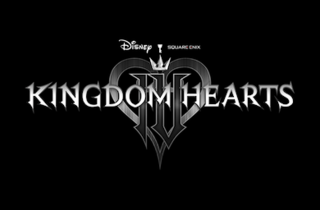
Kingdom Hearts IV is an upcoming action role-playing game by Square Enix. It will be the fifteenth installment in the Kingdom Hearts series, beginning the "Lost Master" story arc. Set after the events of Kingdom Hearts III and Kingdom Hearts: Melody of Memory, returning protagonist Sora has become trapped in the life-like world of Quadratum, while his companions Donald Duck and Goofy try to find and rescue him.
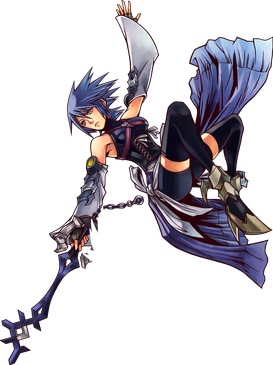
Aqua is a character from Square Enix's video game franchise Kingdom Hearts. First making cameo appearances in Kingdom Hearts II and its updated version Final Mix, she is introduced in the prequel Kingdom Hearts Birth by Sleep alongside her friends Terra and Ventus. The three are Keyblade apprentices training under Master Eraqus, and are the playable protagonists. As the only one among her friends to obtain the rank of Keyblade Master, Aqua is assigned to monitor Terra and Ventus as she combats dark creatures known as the Unversed.
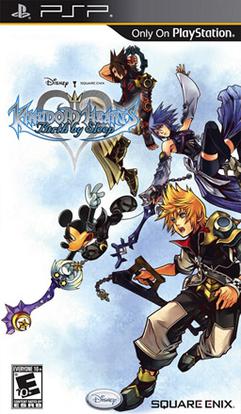
Kingdom Hearts Birth by Sleep is an action role-playing video game developed and published by Square Enix in collaboration with Disney Interactive Studios for the PlayStation Portable, serving as the sixth installment in the Kingdom Hearts series. The game was released on UMD in Japan on January 9, 2010, in North America on September 7, 2010, and in PAL regions on September 10, 2010. An international version of the game titled Kingdom Hearts Birth by Sleep Final Mix was released in Japan in January 2011, featuring the changes made in the non-Japanese versions. A direct sequel, Kingdom Hearts 0.2: Birth by Sleep - A Fragmentary Passage, was released in January 2017 as a part of a bundle of games called Kingdom Hearts HD 2.8 Final Chapter Prologue.

Kingdom Hearts 358/2 Days is an action role-playing video game developed by h.a.n.d. and Square Enix in collaboration with Disney Interactive Studios for the Nintendo DS. It is the fifth installment in the Kingdom Hearts series, and takes place near the end of the first game in parallel to Kingdom Hearts: Chain of Memories, leading directly into the events of Kingdom Hearts II. The game was released worldwide in 2009. The story is told from the perspective of Roxas, and follows his daily life within Organization XIII and his relationship with fellow Organization member Axel; it also introduces a fourteenth member, Xion, who befriends them.

Kingdom Hearts Coded is an episodic action role-playing puzzle video game developed and published by Square Enix, in collaboration with Disney Interactive Studios, for mobile phones. Coded was a Japan-only release announced at the 2007 Tokyo Game Show. A Nintendo DS remake, titled Kingdom Hearts Re:coded, was released in Japan, North America, Europe, and Australia. A cinematic remake of the game was included in the Kingdom Hearts HD 2.5 Remix video game compilation for the PlayStation 3, PlayStation 4, Xbox One, Windows, and Nintendo Switch.
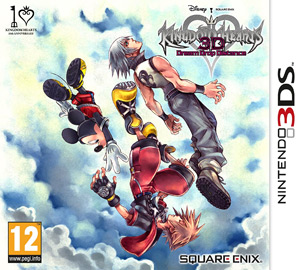
Kingdom Hearts 3D: Dream Drop Distance is an action role-playing video game developed and published by Square Enix for the Nintendo 3DS, revealed at E3 2010. The game is the seventh installment in the Kingdom Hearts series and was released in Japan on March 29, 2012. It was released in Europe on July 20, 2012, in Australasia on July 26, 2012, and in North America on July 31, 2012.
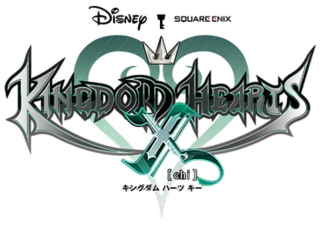
Kingdom Hearts χ, stylized as Kingdom Hearts χ[chi], is a Japanese role-playing browser game developed by Square Enix, BitGroove and Success, and published by Square Enix for web browsers as the eighth installment in the Kingdom Hearts series. Gameplay involves players navigating a customized avatar through Disney-inspired worlds fighting enemies, along with taking down bosses in multiplayer matches in competition with other teams. A version of the game for mobile devices called Kingdom Hearts Unchained χ was released as the ninth installment of the series in Japan in September 2015, and worldwide in 2016.
Tetsuya Nomura is a Japanese video game artist, designer, producer, and director working for Square Enix. He was hired by Square initially as a monster designer for Final Fantasy V (1992), before being shifted towards secondary character designer alongside Yoshitaka Amano for Final Fantasy VI (1994). Final Fantasy VII (1997) had him working in the original story alongside Hironobu Sakaguchi, and marked his debut as the lead character designer, a capacity he would retain for several future installments of the series, as well as other Square Enix titles such as The Bouncer and The World Ends with You. He also created well-known Cactuar, Gilgamesh and Tonberry characters.

Kingdom Hearts: Melody of Memory is a 2020 rhythm action game developed by Square Enix and indieszero, and published by Square Enix for the Nintendo Switch, PlayStation 4, Xbox One, and Windows. It is the fourteenth installment in the Kingdom Hearts series, retelling the events of the series so far, while also being set after Kingdom Hearts III's Re Mind downloadable content scenario.




















